Under the blazing sun, in a brilliant blue light, as if suspended above the turquoise waters of Bora Bora’s lagoon, our catamaran is tugging gently at the chain buried in the coral sand. The constant light breeze of the tradewinds seems inexhaustible. In the distance to the west, I can make out the jagged peaks of Maupiti. I won’t deny it: I’m happy. For sure, on a trip like ours, a happy disposition plays a big part…in being happy. A bit like real life, I suppose? But for long-term cruising, things become more abstract, and relativity less obvious. If you don’t watch out, one day you’ll wind up not being able to see the coconut trees any more, and all that goes with them…
Today is August 4th. One year to the day since we passed the two towers of the Vieux Port at La Rochelle on our way out. Bound for the offshore life! With a simple but ambitious plan: to sail around the world! One year already! A third of our voyage around the planet! Manuia! (Cheers in Polynesian)
I spent several hours on this special anniversary day, working out a few calculations, and some statistics. Not always much fun, but informative.
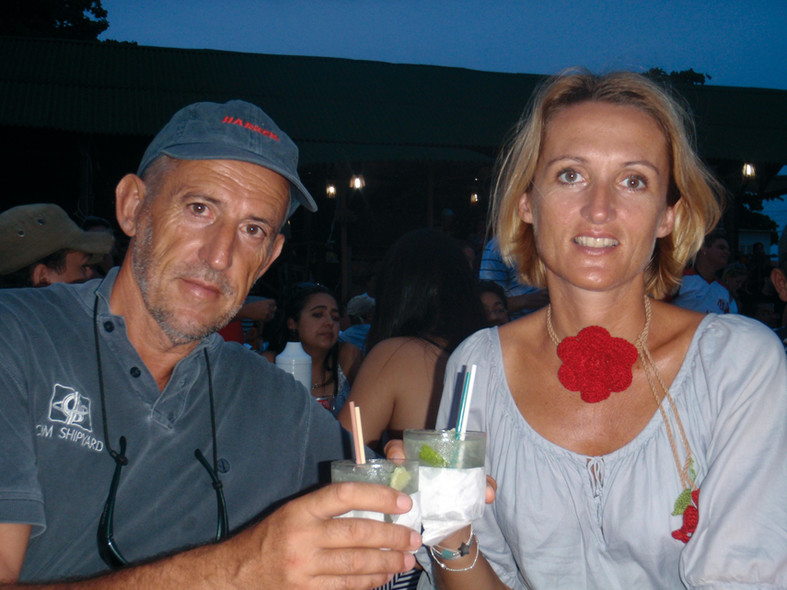
One year into the trip - Happy anniversary to the parents…
The sun rose over Bora Bora’s lagoon, and I rose with it. I have been living closer to nature since we set off. At the chart table, I hit the Display button on the GPS, to check the distance run since leaving La Rochelle: 14,229 nautical miles. At 6,076 feet (1,852 meters) per nautical mile, that equates to 16,374 statute miles (26,352 km) covered on the oceans. As the crow flies (for the romantics among you) and by the great circle route (for the sailors), this morning our boat is situated 9,807 statute miles (15,783 km) from our starting point. We’ve come a long way, but still not halfway round from our port of departure, whose longitude is, give or take, the same as that of the Greenwich Meridian. Our current longitude is 151°45’West. So we’ve got around 28°15’ to cover westwards until we cross the longitude of 180°West, which at the same time will become 180°East. Given that our itinerary is taking us to New Zealand, we’re going to be crossing the 180th meridian somewhere between Tonga and Fiji. So we’ll be able to say that we have reached France’s antipodes, and that we have gone halfway round the world in terms of longitude: in effect, from that moment on, every minute of longitude we make to the west will be getting us closer to our starting point, while for now, every nautical mile we cover is still taking us further away… A bit later on, but before we get to New Zealand, we’ll see something rather special: we will be crossing the International Date Line. By sailing like Magellan, (though a little more modestly of course) and always heading west, we’re going to wind up finding the east! Since we’ve been in the Society Islands, our time zone has been 10 hours behind that of Greenwich, and the ship’s clock at the chart table (I haven’t been wearing a watch for months now…) is set 12 hours behind the current time back home in France. You would be right in thinking that given that there are not more than 24 hours in a day, when the time comes to change the clock again, rather than being 13 hours behind, you are 11 hours ahead! And by continuing west on our sailboat, the dateline is going to deprive us of a whole day out of our lives!!! We still don’t know which one though! Well that’s the theory, but we still have to get back to our original port of departure via South Africa and the Cape of Good Hope, followed by the South Atlantic (St.Helena, Ascension Island), and then finally the Cape Verde Islands and the Azores. This is where we will achieve our circumnavigation, south of the Cape Verde archipelago (we will be crossing our outbound route towards the Saint Peter and Saint Paul Archipelago off Brazil, having departed from Casamance in Senegal, West Africa), and at the same time will have gone back into westerly longitudes … but that’s all a long way off, and we have many miles to cover from here…
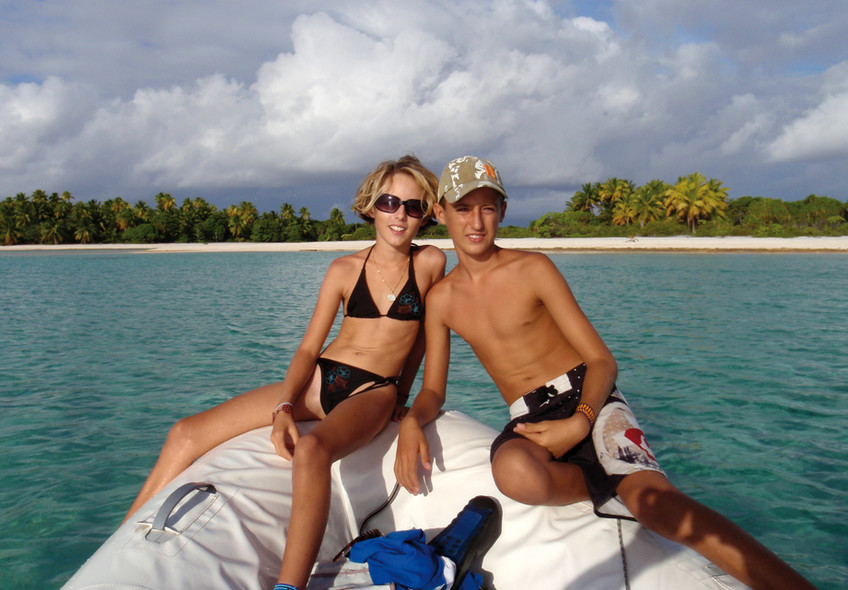
…and to the children of “Jangada”!
Miles of statistics…
I’m buried deep in technical calculations, and I’ve worked out that on average you have to add 3.25% of the shortest distance (known as the great circle distance in the sailing world) between two points we want to travel between to obtain the actual distance over the ocean’s surface that our sailboat needs to cover, taking into account cross-track error, and the captain’s desire to maintain a good point of sail. But it’s up to you to find your own correction coefficient! I then worked out, using our planned route, the total distance to run between each of our intended stops, then the overall distance, by sea first of all, then globally. Here's how the numbers stack up…
In the Atlantic, between August 4th and March 28th of the following year (we went through the 48 miles of the Panama Canal on March 29th and 30th), we covered 8,710 nautical miles. The figure for the Pacific Ocean was more like 11,401 nautical miles, between the Panama Canal and the Torres Strait, located between Australia and Papua New Guinea. As for the Indian Ocean, that added up to 8,675 nautical miles between the Torres Strait and Cape Agulhas, the southernmost point of South Africa. And to accomplish the final part of our round-the-world trip going back up the Atlantic from south to north, from Cape Agulhas back to where we started at the Vieux Port in La Rochelle, France, we would need to do another 6,714 nautical miles. So in all, our circumnavigation would cover a total distance of 35,548 nautical miles. (Note: in reality, Jangada’s log read 36,541 miles when we got back to La Rochelle - 45,050 statute miles or 65,835 kilometers).
So currently here in Bora Bora we have covered around 40% of the predicted overall distance of our journey. Other calculations I was able to make from our logbook enabled me to determine exactly how much time we had spent underway, at anchor or on the dock (or in the yard, on the hard). In one year we had spent 24.77% of our time underway against 71.80% at anchor, and only 3.43% of the time on the dock or in the yard. And just to put that 3.43% in perspective, if we take off the time we spent in the yard in Trinidad (5 days) and the 4 days we left the boat alongside in Jacaré (Brazil) to travel to Olinda and Salvador de Bahia by bus, there would be hardly any time in this column. We were almost never alongside or in marinas! It really is better at anchor! And…it’s free! So looking at it simply, despite being referred to as a “fast boat which doesn’t hang around at the stopovers” (round-the-world in three years is still fairly quick, even though we never had the impression we were speeding), we spent less than a quarter of our time at sea, and nearly three quarters of it at anchor. Useful to know when designing or choosing a cruising boat! Even more so, because most boats sailing long-term take more time than we did when circumnavigating, so the ratio would generally be more like 20% of the time underway and 80% of the time at anchor.
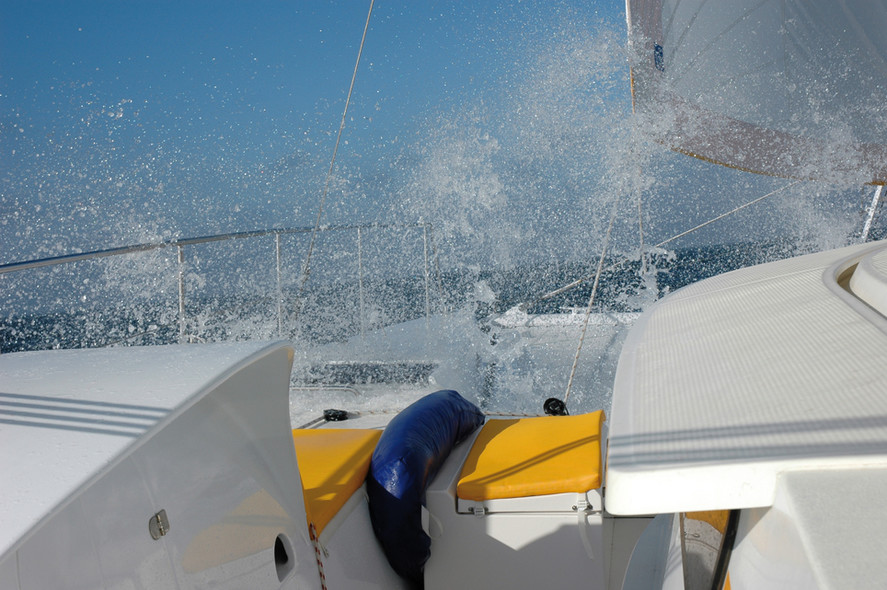
At ten knots, with the wind on the beam, the catamaran makes its way across the oceans.
As regards anchorages, we stopped in precisely 152 in one year! So it’s best to work out how to find the best anchoring spot, and technique for setting your anchor, in all possible conditions: it’s vital for the safety of the boat and for the crew’s peace of mind. Equally important on this subject is the choice of anchoring equipment. I chose to replace our catamaran’s original windlass with a new one (a Lofrans 24V 1500W, deliberately a little over-sized) before setting off, and I also carried 100 meters of 10mm galvanized chain (330 feet of ⅜ inch chain), which I swapped end-for-end every six months to avoid uneven wear. We never anchored with less than 40 to 50 meters of chain, even in 3 meters of water. In Polynesia, certain anchorages meant we had to drop the hook in 35 meters of water… And naturally we Never - with a capital N - used fiber rode for a main anchor: coral is incredibly sharp, and you might one day find your boat up on the reef. We never needed to set tandem anchors or moor Bahamian-style, and only twice did we use our kedge (a lightweight aluminum Fortress) as a stern anchor to keep the boat head to the current in the small tributaries of the Siné-Saloum in Senegal (West Africa).
As for our main engines (2 x 50hp Volvos) we recorded 645 hours on the port motor and 678 hours on the starboard (the vahiné’s cabin was on the port side. Hey…thank you Captain!) When manoeuvering, the two motors worked together, but offshore it was a different story. In very light airs, with a calm sea, or when our speed under sail dropped below 4 knots, I used one motor at moderate revs, which moved the boat along gently, while consuming little fuel. And I made the most of this to run the watermaker at the same time. Which is the only way, despite manufacturers’ instructions telling you otherwise, as it runs on direct current and will quickly deplete your house batteries! In one year we used 3,982 liters of diesel, with an average consumption of 3 liters per hour per motor. We rarely needed to run at more than 1,500 rpm. We bunkered where fuel was cheapest: Santa Cruz de Tenerife (Canary Islands), Trinidad, Panama, with a bit extra as a safety margin in the Galapagos before the 3,000 mile crossing to the Gambier Islands, and finally at Tahiti, where duty-free diesel is available for yachts in transit.
Finally gas for cooking! Our installation on board comprised two large 13kg tanks, the best system to have for long-term cruising (half-size 6kg bottles or Camping-Gaz bottles are best avoided as it’s difficult if not impossible to get them filled or exchanged). We usually went through six in a year, which is one every two months, more or less. And the lady of the house, assisted by her two sidekicks (the children, not the captain, who is useless in the galley and only just about capable of cooking up rice when the others were having a day off…) who loved getting involved with the cooking, frequently served us some wonderful dishes: pizzas, bakes, pies, cakes… and being a long way from a bakery of course, the “Jangada special recipe” bread. If you want a breakdown, our average monthly consumption of gas for cooking was 1.62kg per person. That’s just about it for the figures!

The Argos satellite positions showing our crossing from Casamance (West Africa) to Brazil. In one year, we have only spent a quarter of our time under way.
From the lagoon at Bora Bora, I was often looking towards the west: on the horizon I could see the angular and rugged silhouette of Maupiti, no more than thirty miles from our current position. Contrary to most sailors who pass this way, and who have already decided not to stop there due to the dangerous reputation of the pass, we have decided that we will go and stop there. It would be impossible to miss out on Maupiti. [You can read about this stopover in the next edition of Multihulls World - Ed.]
After that, our route to New Zealand will take us past Mopelia, the Cook Islands and Suvarov (An island to Oneself, by Tom Neale (Ox Bow Press), a New Zealand hermit, who lived there for many years in almost total solitude, before dying from cancer in Rarotonga late 1977). From there we will head south west for almost 500 miles towards one of the Pacific’s curiosities, Beveridge Reef, " lost" 135 miles southeast of the island of Niue. This ring of coral, of which nothing is visible other than a tiny sandbar, has, to the west, a very useful (sometimes essential!) narrow, shallow pass, which in the right conditions allows you to get inside the reef. We might just have the opportunity to drop anchor in the middle of… the sea! Then the island of Niue, where it will be time to revictual (fish and rice gets a bit boring every meal, breakfast included!), before Tonga and then Fiji. From Suva (Fiji) we will be looking for a weather window for the 1,100 nautical mile passage to Whangarei, New Zealand, to avoid a big southwesterly gale coming up from the Southern Ocean… Right, I’m going to download a Grib file from the NOAA website, so I can start working out when might be a good time to get through the pass at Maupiti. There are too many hotels in the lagoon here, too many tourists, and the Pearl of the Pacific has lost its charm. But… it’s beautiful all the same, Bora Bora…

Good preparation - the key to a successful trip…
A few technical points to consider….
• 1 - A particularly safe deck layout, with access forward, hull coaming, flat deck and solid stainless guardrail. Total safety!

• 2 - The most-used open space on board: the cockpit, completely sheltered from the wind, spray and rain by a hard-top bimini with side returns. I only wore my boots and foul weather gear two or three times during our trip round the world!
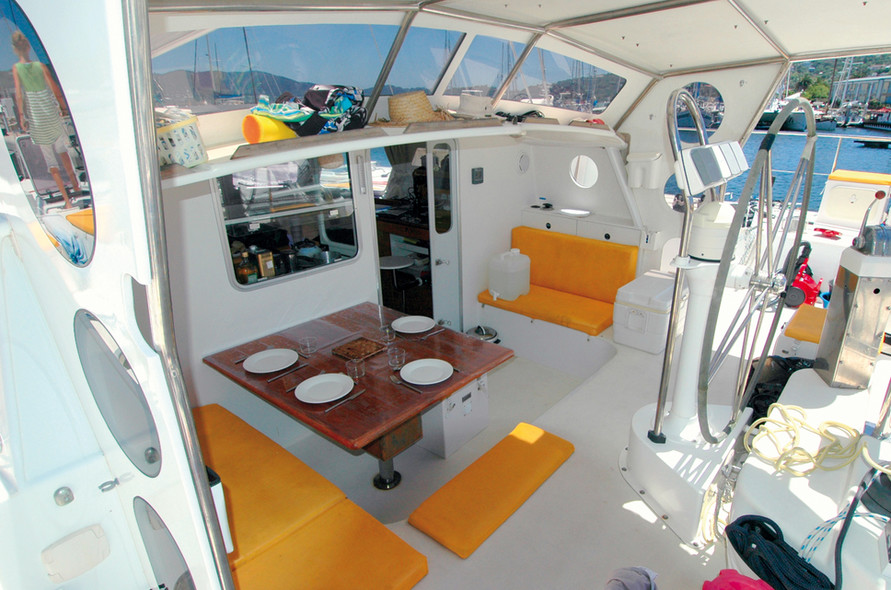
• 3 - Jangada’s chart table, refitted before we set off, with two Durabook computers (dual navigation and communications software), one staying on board and never being connected to the Internet, the other being used to take ashore.

• 4 - With the sole exception of going upwind, the boom preventer is ALWAYS rigged when sailing, cleated off to the central mooring cleat and tensioned by the mainsheet winch. Simple and effective. Accidental gybes? Not on this boat…

• 5 - 2000W portable generator. A lightweight, economic solution, which performs well, whether for the rice-cooker or for the high volume stainless bilge pump, in case of taking water (or even a disc cutter for the stays in the event of a dismasting). Not only for work, but also for battery charging when it was cloudy, but above all for safety.

• 6 - Jangada’s stern: very functional. The design enables us to leave the outboard on the dinghy (3.40 meter RIB with 15hp motor) at all times when we are at sea. There is stowage for the fenders, with multiple lashing points. But a catamaran that's high out of the water…
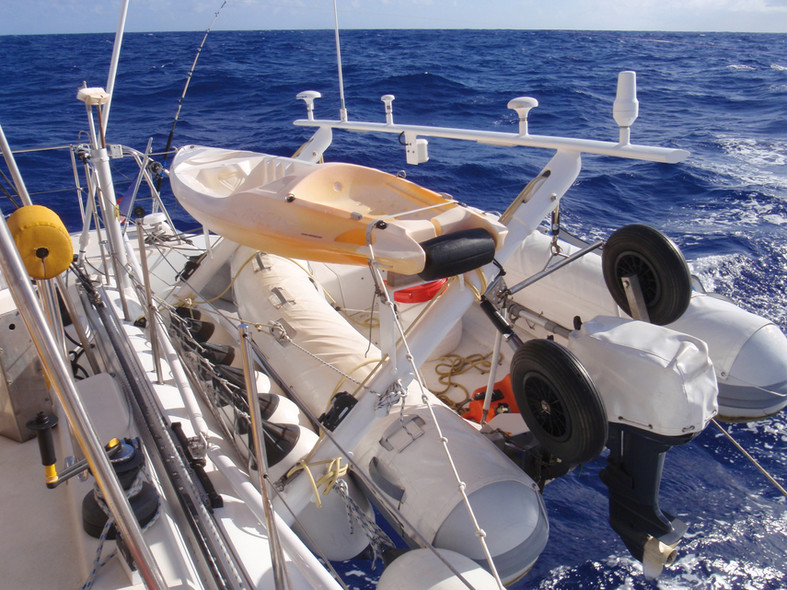
• 7 - The aft steps, with strip-planking fixed to the original hull, measuring 1.20 meters in length and offering a permanent and convenient access to the sea.

• 8 - A well prepared and well protected dinghy is essential. A grapnel with 5 meters of chain, 20 meters of weighted rope. Watertight container, tiller extension and portable electronic sounder.

 Vote for your favorite multihulls!
Vote for your favorite multihulls! 

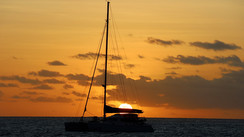

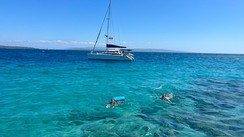
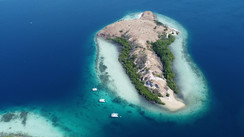
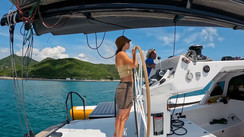

What readers think
Post a comment
No comments to show.